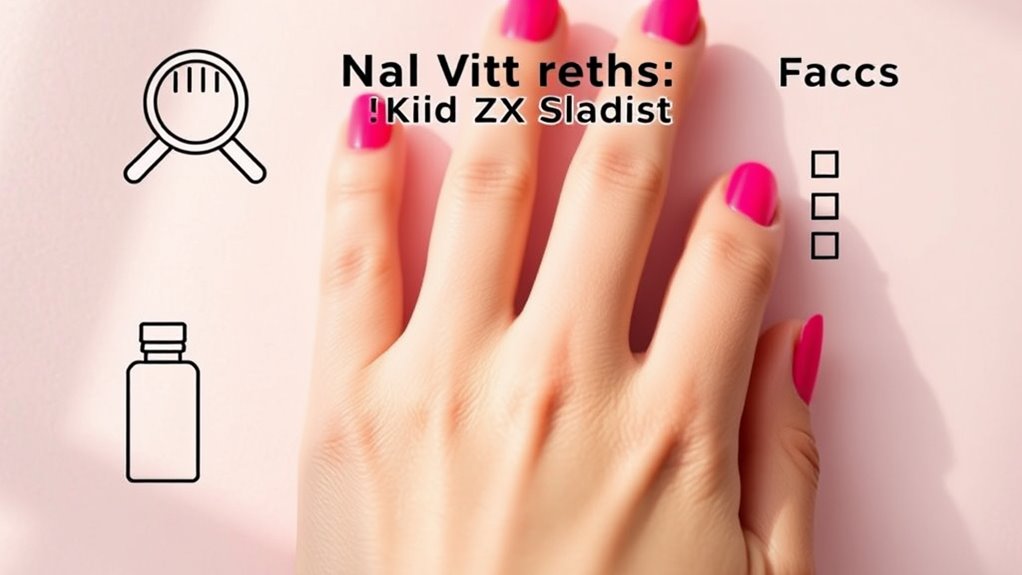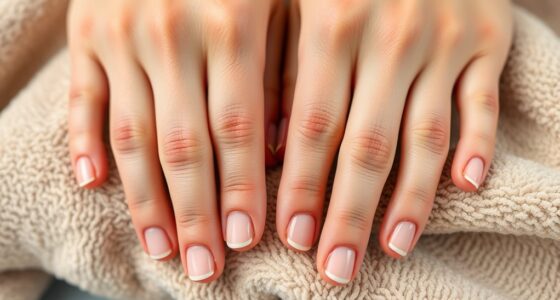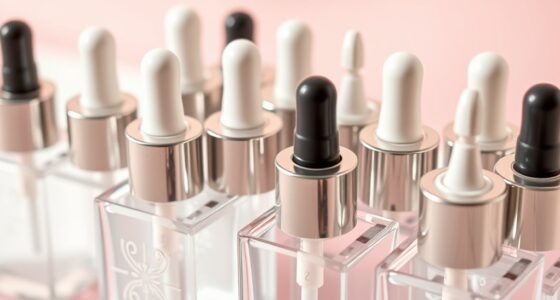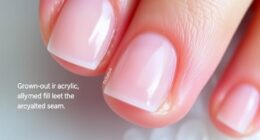Many nail care myths, like avoiding polish or fearing acetone, are just misconceptions. Proper removal techniques, regular hydration, and moderate use of polish actually support healthy nails. Nail problems often stem from improper filing, harsh chemicals, or neglecting cuticles. Instead of avoiding polish altogether, focus on gentle care and nourishing treatments. To discover the truth behind common beliefs and learn how to truly improve your nail health, keep exploring these expert insights.
Key Takeaways
- Occasional use of acetone-based remover with gentle formulas is safe; frequent harsh removal can damage nails.
- Nail polish doesn’t cause permanent damage; proper removal and care prevent dryness and weakening.
- Trimming nails straight across and moisturizing cuticles promotes healthy nails, avoiding damage from over-trimming.
- Professional manicures aren’t inherently harmful if performed properly and with quality products.
- Avoiding polish isn’t necessary for nail health; proper care, hydration, and occasional breaks are more effective.

Many common beliefs about nail care are actually myths that can lead to unnecessary worry or even harm your nails. One widespread misconception is that you should avoid using nail polish remover frequently. People often think that the acetone in nail polish remover is overly harsh and damages nails, but in reality, using it occasionally isn’t harmful if you choose a gentle formula. If you want to keep your nails healthy, it’s more important to focus on proper removal techniques rather than avoiding polish altogether. When removing nail polish, soak a cotton ball in acetone-based remover, press it gently onto your nail, and avoid harsh scrubbing. This helps prevent unnecessary dryness or weakening of the nails. HEPA filtration can help remove airborne pollutants and allergens that may affect nail health indirectly by improving overall air quality.
Using acetone occasionally and gentle removal protects nails more than avoiding polish altogether.
Another myth is that nail polish weakens nails permanently. While some polish formulas might contribute to dryness if used excessively, the real issue lies in how you remove it and care for your nails afterward. Using proper nail polish removal methods and applying nourishing nail strengthening treatments can counteract any potential damage. Nail strengthening treatments, especially those containing biotin or keratin, can reinforce your nails over time, making them less prone to breakage. Don’t believe that you have to give up polish entirely to keep your nails healthy—just confirm you’re using quality products and giving your nails a break periodically to breathe.
Many people also think that trimming nails too short will prevent breakage. However, cutting nails too close to the skin can cause discomfort and increase the risk of infection. The key is to trim your nails straight across and avoid cutting them down to the quick. Regular, moderate trims help maintain nail health and prevent snags or tears. Also, don’t forget to moisturize your cuticles and nails, as hydration plays a vital role in overall nail strength.
Another common misconception is that frequent manicures weaken nails. While some salons might use harsh chemicals or tools, it’s not the manicure itself that’s damaging, but rather improper techniques or neglecting nail care afterward. Always go to reputable salons and follow up with nourishing treatments at home. Applying a good cuticle oil and a strengthening base coat can protect your nails between salon visits.
Frequently Asked Questions
Can Nail Polish Cause Long-Term Damage to Nails?
You might wonder if nail polish causes long-term damage. While some nail polish ingredients, like formaldehyde or toluene, can weaken nails over time, proper nail health maintenance helps prevent damage. Using a base coat, limiting exposure, and giving your nails breaks from polish can protect your nails. When you choose polishes free from harmful chemicals, you reduce the risk of long-term harm and keep your nails healthy.
Is It True That White Spots on Nails Indicate Calcium Deficiency?
Think white spots on your nails scream calcium deficiency? Ironically, they’re often harmless and not linked to calcium at all. In reality, nail white spots usually result from minor injuries or other factors, not a lack of calcium. So, don’t panic or rush to supplement—these spots are common and typically temporary. Next time you see a white spot, remember, it’s likely not a sign your body’s calcium levels are out of whack.
Do Frequent Manicures Weaken or Damage Nails Over Time?
Frequent manicures don’t necessarily weaken or damage your nails if you follow proper manicure safety and maintain good nail health routines. Overdoing harsh chemicals or aggressive filing can cause damage, but using gentle products and giving your nails time to breathe helps prevent issues. Regularly moisturizing and avoiding biting or picking also support nail strength. So, enjoy manicures responsibly to keep your nails healthy and beautiful over time.
Are Cuticles Always Harmful if Pushed Back Regularly?
Pushing your cuticles isn’t always harmful if you do it with proper pushing safety in mind. When done gently, it can improve cuticle health and prevent hangnails. However, aggressive pushing may damage the skin and increase infection risk. Always use soft tools, avoid over-pushing, and moisturize afterward. Remember, maintaining a gentle approach guarantees healthy cuticles without harming your nails or skin.
Can Using Nail Hardeners Improve Weak, Brittle Nails Permanently?
Using nail hardeners can temporarily boost your nail strength, but they don’t provide a permanent solution for weak, brittle nails. The product efficacy varies, and overuse may cause damage or dryness. For lasting improvement, focus on a balanced diet, proper hydration, and gentle nail care. Hardeners can be part of your routine, but don’t rely solely on them for permanent nail health.
Conclusion
Remember, just like peeling away layers of old paint reveals the true surface beneath, busting these nail myths uncovers healthier, stronger nails. I once believed trimming my nails often made them grow faster—until I learned proper care. Now, armed with facts, you can avoid false beliefs and give your nails the love they deserve. Think of your nails as a garden; with the right care, they flourish naturally, free from myths that just hold them back.









